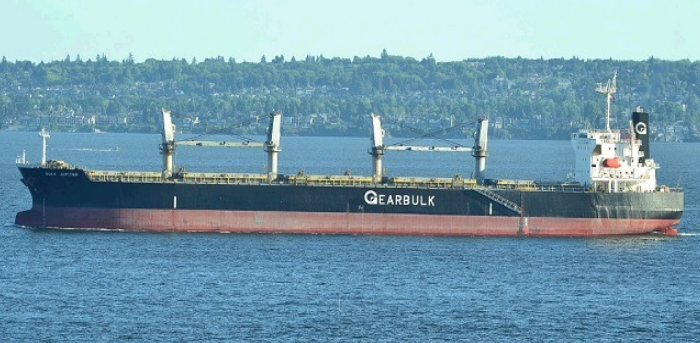On January 2, 2015, the Bahamas-flagged bulk carrier ‘Bulk Jupiter’ sank off Vietnam taking the lives of 18 crew members. Although the accident could not be officially attributed to cargo liquefaction, it opened discussions on the hazards associated with the carriage of bauxite.
Accident details: At a glance
- Type of accident: Sinking
- Vessel(s) involved: Bulk Jupiter (bulk carrier)
- Date: 2 January 2015
- Place: off Vietnam
- Fatalities: 18
- Pollution: No significant environmental pollution was reported.
The incident
On 2 January 2015, the Bahamas-flagged Bulk Jupiter, with 19 crew members onboard, was carrying 46,400 tonnes of bauxite from Malaysia to Hong Kong.
While off Vietnam on New Year’s Eve, the vessel received an email from their weather routing provider highlighting adverse weather conditions expected in the region.
In the next day, the vessel started rolling more heavily as the weather started to deteriorate.
At approximately 0640, the general alarm was sounded followed by an announcement by the Master directing all crew to proceed to the bridge.
While in his cabin, the chief cook felt the vessel suddenly starting to roll more heavily, particularly to starboard.
He left his cabin in order to make his way to the port side lifeboat, at this point the vessel suffered a black out, emergency lights then came on, and the vessel stopped rolling and adopted approximately a 45o list to starboard.
[smlsubform prepend=”GET THE SAFETY4SEA IN YOUR INBOX!” showname=false emailtxt=”” emailholder=”Enter your email address” showsubmit=true submittxt=”Submit” jsthanks=false thankyou=”Thank you for subscribing to our mailing list”]
Due to the angle of list, the Chief Cook was unable to make his way to the port side access door and decided to utilize the internal staircase and proceed up to ‘C’ deck, where he met the Master.
He instructed the Chief Cook to follow him and together they exited the accommodation block via the starboard side access door. No other crew were seen onboard after that time.
Having exited the accommodation area of the vessel, both men found themselves on a small platform on the starboard side, aft external stairway with the waves washing over them.
The Master, wearing his lifejacket, jumped into the sea followed shortly after by the Chief Cook who at this point had donned his lifejacket – neither were wearing an immersion suit.
The two men stayed together while swimming away from the vessel prior to it sinking.
As they looked back from a safe distance, despite the heavy seas, they could just see that the vessel had almost disappeared beneath the waves.
At 1410, the good Samaritan container ship ‘Zim Asia’ reported sighting the two persons and believed them both to be alive.
The tugboat ‘OLNG Muttrah’ headed to assist and by 1556 the two crew were recovered onboard, but only the Chief Cook was alive. Two more crew members were recovered deceased.
A total of 9 vessels and 3 aircraft were assisting with the SAR operation to find the remaining crew. Search and rescue efforts continued for a further 2-3 days, but no further crew were located.
Findings
The official investigation report underlines that:
1. The Bulk Jupiter’s Master and senior crew members were well versed in dry bulk cargo operations, while the company’s management and SMS procedures were also adequate.
The Company provided adequate guidance and direction to the Master and maintained a level of management enough to allow normal operations to be conducted safely.
However, three factors failed to raise adequate awareness or warning signs:
- the uncharacteristic speed reduction en route,
- the results of the requested ‘Can Test’ and
- the incomplete noon reports that should have informed the Company on the condition of the cargo in the holds.
2. Additionally, there was significant evidence to identify that the 46,400t of bauxite loaded over the course of the 13-day period had an average moisture content of 21.3%.
Despite this, there is no physical evidence to confirm what caused the vessel to adopt an unrecoverable list to starboard and subsequent capsize.
It was noted that a total of 186.55 hours of loading was lost due to rainfall – the equivalent of 7 days of loading over the period. The infrastructure available to adequately store and transport bauxite in Kuantan increased the exposure of the bauxite to the elements.
Despite the crew’s diligent response to the rain by continually opening and closing the hatch covers to reduce the ingress of water, the cargo remained exposed whilst on the quay side, in stockpiles and in the trucks.
An independent inspection was not requested by the Master to verify the properties of the cargo prior to loading onboard. The absence of an independent inspection resulted in the cargo being loaded without its physical properties and moisture content being verified against the parameters of the IMSBC Code schedule or the cargo declaration form.
Considering the extreme weather conditions and storage facilities available it was acknowledged that the cargo was very wet and that measures to protect the cargo on shore from further rain were not effective in preventing further wetting.
3. The previous class and special survey inspections indicate no structural integrity failures, so the possibility of a catastrophic structural failure is considered low.
[/two_third_last]
Lessons learned
Although liquefaction could not be officially highlighted as the key cause of the accident, discussions were brought in the spotlight regarding the dangers associated with bauxite cargo. Cargo liquefaction remains a key area of concern for shipping safety, accounting for 101 losses of life and 9 losses of ships for the years 2008-2017.
Cargo liquefaction occurs when dry bulk cargoes with high moisture contents start to behave like liquids when the ship is moving. Such cargoes shift rapidly in the holds of a ship, resulting in the free surface effect, making the ship unstable and leading it to capsize.
On the aftermath of the tragedy, IMO’s Sub-Committee on Carriage of Cargoes and Containers (CCC 2) considered matters related to the carriage of Bauxite, which was listed in the IMSBC Code at that time as a Group C cargo (cargoes which are neither liable to liquefy nor possess chemical hazards). This means that Bauxite carried some risks but did not present the dangers associated with Group A and B cargoes.
However, the Sub-Committee’s work indicated that Bauxite does present a risk caused by moisture and, therefore, some Bauxite cargoes should be treated as Group A cargoes.
In September 2017, after further discussion was held at the IMO and having noted that some Bauxite cargoes should be classified as Group A, the following were finalized:
- The draft Test Procedure for Determining the TML for Bauxite.
- The draft individual schedule for Bauxite of Group A having the Bulk Cargo Shipping Name “BAUXITE FINES”.
- The draft amendments to the individual schedule for Bauxite of Group C.
Pending expected entry into force of the draft amendments to the IMBSC Code on 1 January 2021, operators should be very careful and take the appropriate action when handling and carrying Bauxite in bulk and the conditions in line with the IMO circular CCC.1/Circ.2/Rev.1.
Following the accident, it was recommended that operators must always check the shipper’s cargo declaration and moisture content certificate carefully, especially noting:
- the description of the cargo;
- how it is treated under the IMSBC Code; and
- the stated moisture content.
Watch a video by AMSA on the issue:
Did you know?
A significant number of bulk carriers have been lost suddenly at sea in the last decades and cargo liquefaction has been considered as one of the main possible scenarios to these disasters: The speed of the sinking is considered a typical case of cargo liquefaction, although this cannot be confirmed. To name a few:
- Nur Allya – August 2019
- Emerald Star – October 2017
- Harita Bauxite – February 2013
READ THE INVESTIGATION REPORT HERE
LEARN FROM THE PAST: Read in this series















































































































The investigation report produced by the Bahamas Maritime Authority was little more than the usual flag state ‘white wash’, designed to ensure shipowners/flag register clients were not implicated. The reality is the master was not competent as the evidence showed that he did not understand or know how to conduct a can test – as was recommended by ship managers – to make even a basic assessment of the bauxite cargo’s condition. Even worse, ship managers did not bother to follow up to ensure their recommendation had been accomplished. As for the shippers of the cargo, the evidence indicates they either knew the cargo was wet and unsafe and lied or were criminally and culpably ignorant of the danger it posed to the ship and her crew. Eighteen crew members were sentenced to death as a consequence of ignorance, incompetence and criminal negligence. The perpetrators got away with a limp ‘silly boys, don’t do it again’ slap on the wrist from flag state and the IMO. Nothing has really changed.